
The Rubiaceae are a family of flowering plants, commonly known as the coffee, madder, or bedstraw family. It consists of terrestrial trees, shrubs, lianas, or herbs that are recognizable by simple, opposite leaves with interpetiolar stipules and sympetalous actinomorphic flowers. The family contains about 13,500 species in about 620 genera, which makes it the fourth-largest angiosperm family. Rubiaceae has a cosmopolitan distribution; however, the largest species diversity is concentrated in the tropics and subtropics. Economically important genera include Coffea, the source of coffee, Cinchona, the source of the antimalarial alkaloid quinine, some dye plants, and ornamental cultivars.

Galium is a large genus of annual and perennial herbaceous plants in the family Rubiaceae, occurring in the temperate zones of both the Northern and Southern Hemispheres. Some species are informally known as bedstraw.
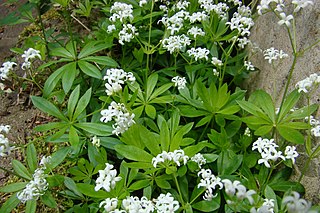
Galium odoratum, the sweet woodruff or sweetscented bedstraw, is a flowering perennial plant in the family Rubiaceae, native to much of Europe from Spain and Ireland to Russia, as well as Western Siberia, Turkey, Iran, the Caucasus, China and Japan. It is also sparingly naturalized in scattered locations in the United States and Canada. It is widely cultivated for its flowers and its sweet-smelling foliage.

Galium verum is a herbaceous perennial plant of the family Rubiaceae. It is widespread across most of Europe, North Africa, and temperate Asia from Palestine, Lebanon and Turkey to Japan and Kamchatka. It is naturalized in Tasmania, New Zealand, Canada, and the northern half of the United States. It is considered a noxious weed in some places.

Galium mollugo, common name hedge bedstraw or false baby's breath, is a herbaceous perennial plant of the family Rubiaceae. It shares the name hedge bedstraw with the related European species, Galium album.
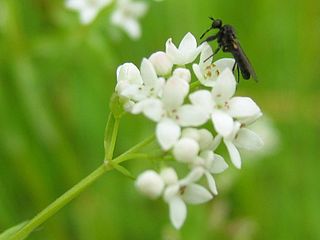
Galium palustre, the common marsh bedstraw or simply marsh-bedstraw, is a herbaceous annual plant of the family Rubiaceae. This plant is widely distributed, native to virtually every country in Europe, plus Morocco, the Azores, Turkey, Turkmenistan, Western Siberia, Greenland, eastern Canada, St. Pierre & Miquelon, and parts of the United States. The species is classified as a noxious weed in New York, Pennsylvania, Massachusetts, Connecticut, Vermont and New Hampshire. It is considered naturalized in Kamchatka, Australia, New Zealand and Argentina.

Galium boreale or northern bedstraw is a perennial plant species of the Rubiaceae family. It is widespread over the temperate and subarctic regions of Europe, Asia and North America including most of Canada and the northern United States.
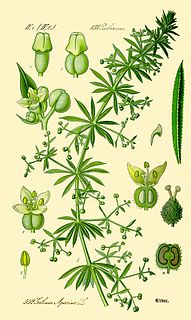
Galium aparine, with common names including cleavers, clivers, catchweed and sticky willy among others, is an annual, herbaceous plant of the family Rubiaceae.
Galium aschenbornii is a species of flowering plant in the genus Galium, native to Mexico, Central America, Colombia and Ecuador.
Galium argense is a plant species in the Rubiaceae. It is endemic to California and native to Inyo and San Bernardino Counties. It is dioecious, with male and female flowers on separate plants.
Galium coloradoense, the Colorado bedstraw, is a plant species in the Rubiaceae. It is native to the southwestern United States: Arizona, New Mexico, Utah, Colorado, and southern Wyoming. It is dioecious, with male and female flowers on separate plants.
Galium hallii is a species of plants in the family Rubiaceae. It is known only from southern California:. It is dioecious, with male and female flowers on separate plants.
Galium jepsonii, with the common name Jepson's bedstraw, is a rare flowering plant species in the Rubiaceae — Madder family.
Galium munzii is a species of plant in the family Rubiaceae. It is native to California, Arizona, Nevada, and Utah.

Galium obtusum, the bluntleaf bedstraw, is an herbaceous plant species in the family Rubiaceae. Bluntleaf bedstraw is a wildflower native to eastern Northern America.
Galium parishii is a species of plants in the family Rubiaceae. It is native to southern California and southern Nevada.
Galium proliferum is a species of plants in the Rubiaceae. It is native to southern California, southern Nevada, southern Utah, Arizona, New Mexico, Texas, Coahuila and Nuevo León.
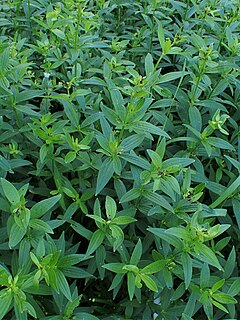
Galium rubioides is a species of plants in the family Rubiaceae, native to Europe and Asia. Natural distribution is from Austria and Croatia east to Russia and Turkey, plus the Caucasus, Western Siberia, Kazakhstan, northern China and the Amur region of Russia. The species is also reportedly naturalized in Northampton County, Pennsylvania.
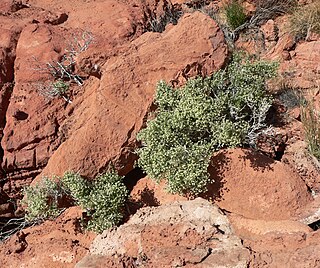
Galium stellatum is a species of plant in the family Rubiaceae. It is widespread across most of Arizona, and found also in Baja California, Baja California Sur, southeastern California, Nevada, Utah. It is dioecious, with male and female flowers on separate plants.

Galium wrightii, common name Wright's bedstraw, is a species of plants in the Rubiaceae. It is native to northwestern Mexico and southwestern United States: Sonora, Chihuahua, Arizona, New Mexico, western Texas, southwestern Utah, southern Nevada and southeastern California In California, this plant is ranked as rare, threatened, or endangered in CA; common elsewhere.











